|

by Warren Aston
July 14,
2020
from
Popular-Archaeology Website
PDF format
|
Warren Aston is an independent researcher
based in
Brisbane, Australia.
He
studied archaeology at the University of Queensland, and
has been involved in archaeological projects in Mexico
and Oman over several decades.
He
can be reached at:
astonwarren@hotmail.com |

Over
400 mounds on New Caledonia in the southwest Pacific may
mark a human presence predating the current earliest
generally accepted dates by thousands of years.
The following paper, relates a detailed review of the
investigation of enigmatic tumuli, or mounds, on the
Isle of Pines, part of the island French territory of
New Caledonia in the South Pacific.
The
origin and purpose of these tumuli have eluded
investigators and scientists for decades, sparking
various conjectural explanations for their existence.
If
the tumuli represent the work of humans, they would
provide evidence for human occupation of the island
thousands of years before the currently accepted dates
for human habitation.
The
author suggests a new hypothesis for further study.
RECOVERING A
PRIMAL EVENT IN SOUTH PACIFIC PREHISTORY
NEW CALEDONIA'S TUMULI - TOWARD
RESOLUTION
The ancient migrations settling the South Pacific remain poorly
understood.
This is particularly so
when the New Caledonia sequence is considered and where perhaps the
greatest archaeological mystery of the region awaits resolution.
Scattered across the
Isle of Pines
more than 400 tumuli, or mounds, shelter substantial cement
blocks, many with a circular shaft running through their centre.
The only tumulus fully
excavated also revealed a large cone-shaped iron object buried
directly beneath the shaft, function unknown.
Described by two
archaeologists as recently as 2015 as "a kind of archaeological
nightmare" 1 the origin and purpose of the tumuli remains
enigmatic, the mystery compounded by studies revealing dating
thousands of years earlier than settlement models currently allow.
The paper outlines
various investigations over the last century before arguing that
excavation data from two seminal studies (Chevalier 1963 and Lagarde
2017) demonstrate that non-anthropic explanations - notably the
long-standing avian theory - fail to address the substantial data
indicating a human presence on the island predating the Early Modern
Era.
A new hypothesis for the
original purpose of the tumuli is presented, one based on the
accumulated data.
NOMENCLATURE
While the term "tumulus" - a mound - is accurate enough, the word
can have an unfortunate association in English with burial
practices.
To remove the ambiguity
provided by the fact that there are, of course, numerous other
"mounds" of varying characteristics, both on the Isle of Pines and
elsewhere, the term "tumulus" in this paper refers to what are more
accurately described as a "cement-core tumulus."
The cement interior of the tumuli is typically referred to as a
"cylinder" in the various early reports.
As this term conveys the
implication of circularity, and these structures are actually
cube-shaped, this paper will use the term "core" as more accurate
terminology.
INTRODUCTION
The
Melanesian Kanak population is
believed to have inhabited the islands of New Caledonia since the
so-called Lapita period around 1350 BC.
The first European
arrivals on Kunie, the Isle of Pines, in the early nineteenth
century noted the numerous tumuli, but the indigenous population
ascribed no particular significance to them.
This led to some early
investigations and conjecture, but no sustained attention for many
decades.
Proper studies and
initial excavations commenced only in 1959. Since then, scholarly
opinion has advanced - and discarded - a range of ideas concerning
the tumuli, but without a consensus to the present.
MATERIAL
REMAINS - A DESCRIPTION
More than 400 large tumuli are dotted over much of the Isle of Pines
with a concentration on the central so-called "Iron Plateau," plus
about 20 at particular locations in the south of the main island of
New Caledonia.
No systematic attempt has
yet been made to locate tumuli elsewhere on the main island or,
indeed, the other islands of the group.
Early settlers assumed
these were simply ancient burial mounds, but no graves, bones,
pottery, charcoal, etc. have ever been found in them.
The locations of the tumuli generally appear to be quite random
regardless of the terrain, although in a very few places a possible
alignment or circle might be perceived in aerial images. More
certain is the fact that most tumuli are rarely spaced less than 200
m apart, as geologist Jacques Avias noted in 1949. 2
The tumuli average about
3 m in height with a circumference ranging between 15-25 m. 3
While the majority of
tumuli fall into this size range, a handful of oval shaped
structures have also been described; one that was examined measured
3 m high and 16 m wide. 4
New investigations have revealed that as much lies beneath the
tumuli as above; the mounds contain a large square or oblong core
made of a high-grade concrete. The most detailed excavation to date
of a tumulus was on the Isle of Pines in 1959, revealing a core
almost 2.60 m tall and a substantial 1.8 m across.
At several points along
the height of the core it was encircled by rings of iron-oxide
nodules. 5
The oval-shaped tumulus
noted earlier proved to have two concrete cores, each 2 m diameter,
and placed 5 m apart. 6 While the concrete cores so far
examined appear to consist of homogenous material, the upper part of
one of the Paita cores that was completely demolished contained
irregular pockets of soil of varying sizes. 7
With regard to the soil
intrusions, excavation data remain too limited to draw any
conclusions.
Most intriguingly, the Isle of Pines tumulus excavated by Chevalier
in 1959 revealed that buried directly below the centre of the core
was a symmetrical cone or top-shaped iron object, pointing down and
surrounded by 3 rings of large iron nuggets.
It was over 2 meters
long... 8
As will later be
discussed, Chevalier's excavations of two tumuli at Paita also
revealed puzzling features below the concrete core. One of the
tumuli completely demolished on Paita revealed a separate "vaguely
circular" slab of cement beneath it, in the middle of which was a
wide (90 cm) and deep (1.8 m) trench, oriented east-west, and two
holes at different depths.
The other Paita tumulus
did not appear to have a comparable feature beneath the core. 9
Another, most significant, feature was not noted until the
excavations led by Jack Golson in 1959-1960: a circular, vertical,
shaft running from the top of the core at its centre down to its
base; this will be discussed further.

Figure 1:
Known tumuli locations
on the Isle of Pines
(after D. Frimigacci, Notice explicative de la feuille Ile des Pins:
Carte géologique à l'échelle, Paris: BRGM, 1986, 28).
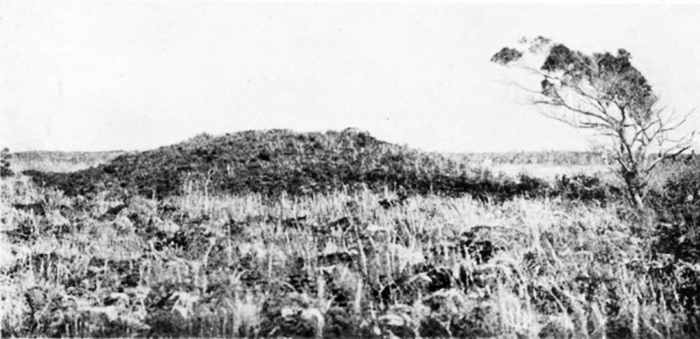
Figure 2A:
One of hundreds of enigmatic "tumuli" on the Isle of Pines.
This early photograph was published by R. H. Compton in 1917
and shows one of the rare double-cored mounds.
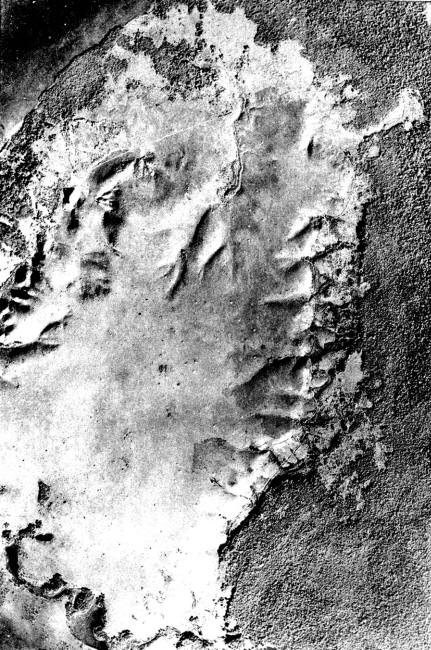
Figure 2B:
A 1949 aerial view of the "Iron Plateau" of the Isle of Pines
with scores of tumuli visible before reforestation of the area.
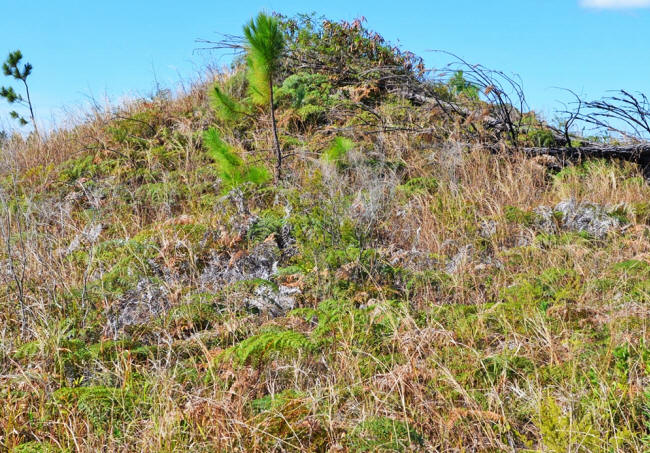
Figure 3:
Today,
hundreds of mounds lie in open land
or in pine forests on the Isle of Pines.
Photograph by the author, 2017.
MODERNS
ENCOUNTER AN ENIGMA
Some of the underlying issues for some aspects of New Caledonian
and, more generally, for South Pacific pre-history remaining in
somewhat of a stalemate were discussed in Roger Green & J. S.
Mitchell's 1983 paper, "New Caledonian Culture History: A Review of
the Archaeological Sequence." 10
The authors provide the
following reasons:
-
firstly, over the
years research has appeared in a great range of venues and
is seldom integrated.
-
secondly, not all
findings have been published in readily available sources
(and sometimes not published at all)
-
thirdly, a
perceived language barrier as the main sources are
[obviously] in French and English
-
finally, one of
the primary sources (Gifford & Shutler, 1956) has some
deficiencies in its presentation of data - something Green
and Mitchel discuss - and investigators since have not
followed a consistent terminology or frame of reference
A chronological
examination of the main sources reveals the long-standing confusion
over how to account for the tumuli within the accepted time-frame of
human arrival in New Caledonia, as well as the factors outlined by
Green and Mitchell just noted.
To examine even a brief
history of modern sciences' attempt to understand these structures
is to encounter a spectrum of human foibles, ranging from honest
reporting with rational analysis to degrees of disingenuity and,
above all, avoidance.
Early observers on the Isle of Pines realized that these scattered
mounds represented a mystery and were quick to seek answers.
As early as 1897,
Frenchman Theophile-Auguste Mialaret reported "opening" a
tumulus, but finding nothing of interest. 11
In 1917, Englishman
R.H. Compton reported in The Geographical Journal the
"remarkable" dome-shaped mounds of earth:
"…excavation has
revealed no contents of interest…various suggestions have been
put forward to explain them."
In both cases their
efforts were watched, as Compton noted,
"without fear by the
indigenous people who, while claiming that they did not make the
tumuli, could give no explanation for their origin."
He concluded:
"I am quite unable to
offer any suggestion as to their origin myself." 12
The 1949 paper by Avias
included an aerial photo (reproduced here as Figure 2B) showing
"nearly two hundred" tumuli on the central "Iron Plateau."
He proposed a series of
ancient arrivals in the southern Pacific, predating the Melanesians,
,
"…at least the
following hypothesis can be put forward: a civilization…
preceded the present Kanak civilization… this civilization had a
Neolithic industry more advanced than the indigenous people."
13
That the structures
contained a massive concrete core remained unsuspected and unknown
until proper excavations on the Isle of Pines began in 1959.
Leading the post-war
vanguard of serious investigators were two archaeologists, Jack
Golson and Luc Chevalier.
From 1959-1960 British-born Australian archaeologist Jack Golson led
a team excavating four "tumuli" on the Isle of Pines, finding that
there were at least 3 types of structures.
Golson's team went on to
map more than 120 mounds and excavated three of them. They viewed
the concrete cores as "anchors" and established, by probing their
centers, that "many" other mounds also had a cement core.
As briefly noted earlier,
their excavations revealed that at least several of the cores had a
vertical hole running through them, a feature they termed
"postholes," but could not determine what function the shaft might
serve.
Golson published a brief report in 1961, "Report on New Zealand,
Western Polynesia, New Caledonia, and Fiji" concluding:
"The mystery of the
tumuli is thus, despite this spate of activity, as great as
ever. Who were these concrete makers of New Caledonia and what
is the function of their constructions?
Native tradition is
silent and the archaeologist as yet ignorant." 14
In 1963 he published more
data from his expedition in "Rapport sur les fouilles effectuees a
l'ile des Pins (Nouvelle Caledonie) de Decembre 1959 li Fevrier
1960" and with Daniel Frimigacci in 1986, "Tout Ce Que Vous Pouvez
Savoir Sur Les Tumulus, Meme Si Vous Osez Le Demander,'' 15
providing a comprehensive summary of the topic.
Luc Chevalier, the French archaeologist, was led by unexpected
circumstances in September 1959 to shed further light on the tumuli.
Based in
Noumea as curator of the National
Museum, Chevalier traveled to the Isle of Pines to investigate a
report that local workers upgrading a road had encountered a solid
white "rock" at the centre of a tumulus they were demolishing for
road-building material.
With a half-exposed mound
as a starting point, Chevalier immediately began excavating until
the southern side of the tumulus core was exposed and the unexpected
object beneath it revealed.
Chevalier describes it as
an "iron oxide rock" about 2.40 m tall - almost as tall as the core
itself - and a maximum diameter of 1.10 m, resembling a symmetrical
upside-down "top" or cone, pointing down.
At that point, the entire
structure threatened to collapse; amid several small landslides
excavation was halted.
In 1963, Chevalier's
final report, "Le Probleme des Tumuli en Nouvelle-Caledonie"
appeared in the Bulletin de la Societe des Etudes Melanesiennes;
16 It deserves close reading.
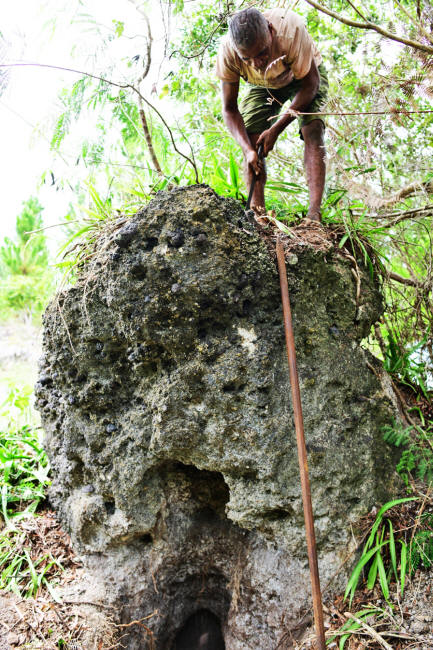
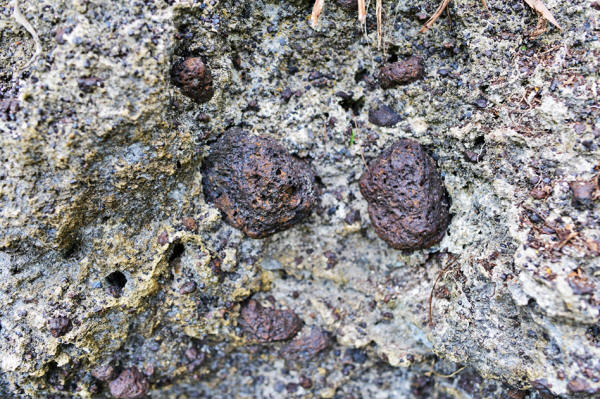
Figure 4A, 4B (2 images):
The exposed 2 meter high concrete core
from the tumulus excavated by Chevalier in 1959,
with a close-up view of large iron nodules
embedded in it.
Photographs by the author, 2018.
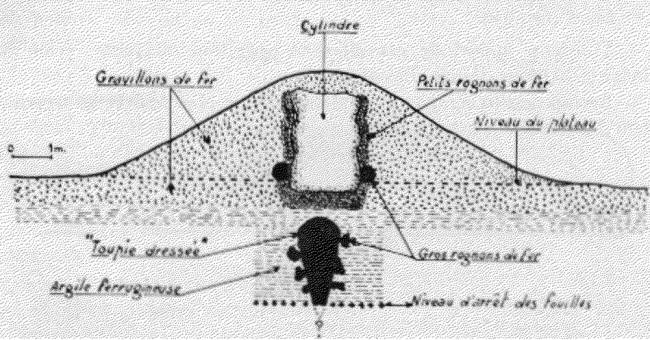
Figure 5:
Chevalier's 1963 excavation report (his Fig. 5)
shows the interior of the mound after excavation.
The rings of iron nodules and the top-shaped object
buried beneath the central core are clearly shown.
Chevalier then examined
other nearby tumuli on the Iron Plateau, determining that at least
many of them also contained a central core made of "white mortar"
and making particular note of the oval-shaped tumulus that contained
two cores.
Returning to Noumea, he
then investigated several tumuli in the region of Paita just north
of the capital.
An identical situation to
what had happened on the Isle of Pines involving road workers was
replicated in Paita; this time uncovering two concrete-cored tumuli
about 300 m apart.
It was here that several
intact Placostylus snail shells found embedded in the concrete
matrix of the cores and were sent, with samples of the cement, to a
laboratory in Paris for dating.
His report shows images
of the exposed concrete cores of 2 of the Paita tumuli being
demolished.
Despite anticipating further excavations that would "verify the
presence and shape of this [cone-shaped] stone under the other
tumuli," 17 Chevalier's next excavations at Paita would
only raise more questions.
Aside from the absence of
any mention of Golson's "post holes" in the concrete cores (about
which Chevalier may not have been aware) in his reports, those he
examined remained completely analogous to those in the Isle of Pines
tumuli although, as noted earlier, the Paita cores had differing
material beneath them and the cone-shaped object was not found in
these part-excavations.
Nor does Chevalier
mention returning to the Isle of Pines, although he expressed
optimism that a complete excavation campaign there would be possible
the following year, ie. 1960. 18
Among other significant aspects, Chevalier noted that on both the
Isle of Pines and at Paita the excavations were culturally sterile;
that is, no tools, pottery, charcoal etc. could be found.
The closest thing to a
cultural artifact was the apparent surplus of construction materials
found near the two Paita tumuli excavated, a quantity of lime mortar
mixed with silica near one and a 10 m wide elevation of silica
gravel near the other.
Both offered clear
indications of human involvement likely, as Chevalier recorded,
being the places where cement was prepared before being poured into
the centre of the tumulus to form the core. 19
He commented,
"There is no doubt
that the same people who made the tumuli on the Isle of Pines
also made those in the region of Païta.
The only difference
between them is that the tumuli of Païta are made of a supply of
silica present everywhere, while those on the Island of Pines
used the "iron shot" which is found in abundance on the plateau…
It is also necessary
to determine the origin of most of the mortar: or is this the
result of the calcination of coral?… it is curious to find no
fragments of charcoal in the mortar.
[It indicates] a
space between the time of the construction of the tumuli and the
pre-European Melanesian era."
The conclusion of his
report "Many Questions Without Answers," summed up the facts:
"The tumuli of New
Caledonia are undoubtedly the result of an ancient human
activity of which there is no trace in the local tradition.
Remember that the
manufacture and use of lime was not known to the natives before
the arrival of the missionaries in 1843.
One is perplexed by
the importance of the work done to erect these monuments. When
one thinks that a tumulus represents on average, a volume of 200
m3 and that on the Isle of Pines alone there are more than 300
tumuli, requiring a very large workforce.
However, this
workforce during its work, had to leave some traces of its
passage, its life, its activities… to date, no trace, no
evidence, no vestige, either inside or outside the tumulus has
been found."
Chevalier closed with the
following, very perceptive, observation:
"…a final question
arises in our mind: the builders of these tumuli knew perfectly
the principle of manufacturing and using the mortar for the
erection of the cylinder.
Why did they not use
this knowledge for other works, other realizations, their
dwellings, for example…?
Would they have
reserved this knowledge only for the tumuli, conferring to these
monuments a particular character, even a sacred one?"
Had more attention been
given to these questions by those who came after Luc Chevalier, our
understanding of these structures would have advanced more rapidly
than it has and without the avoidance of facts and obfuscation in so
much of the commentary since then.
DATING
The results of two chemical analyses of the components of the
concrete (one from the Isle of Pines, one from a Paita tumulus)
appeared in Chevalier's 1963 report and are quite comparable.
The primary disparity
evident in the Fe and Si amounts reflecting the two very different
environments of origin.
The dating of the mortar
and snail shells from a core excavated on Paita by Chevalier was
published in a 1966 paper in Radiocarbon. This gave radiocarbon
dates for surface and interior mortar (7070 ± 350 and 9600 ± 400 BP
respectively), plus a date for Placostylus snail shells on the
surface of a cylinder (12,900 ± 450 BP).
Echoing Chevalier's
belief that the tumuli "testify to an important human activity
completely extinct today…" the report's authors noted that if the
cores were really man-made "…they are by far the most ancient
mortars known." 22
Radiocarbon dating by
others since have served to confirm Chevalier's very early dates.
For example, a 1972
dating of tumulus cement yielded ages ranging from 4120 ± 90 to 7710
± 70 BP. 21
Space constraints prevent a full review here of those who have
accepted this dating, but they include scholars such as,
-
Brookfield & Hart
in 1971, 22 Fr. Marie-Joseph Dubois (1976)
23
-
Richard Shutler
Jr. (1978) 24
-
Peter Bellwood
(1978) 25
-
Roger Green & J.
S. Mitchell (1983) 26
-
Kerry Ross Howe
(1984) 27
-
John R. H.
Gibbons & Fergus G. A. U. Clunie (1986) 28
-
Christophe Sand
(1999) 29 and Patrick V. Kirch (2000 and 2017)
30
It is an understatement
to say that the disconnect between the Placostylus and mortar dating
and the conventional understanding of human settlement in the
Pacific is unbridgeable.
To contemplate people
arriving in New Caledonia as early as 12,000 years ago simply cannot
be massaged into the accepted scenario.
Consequently, many -
perhaps most - of these researchers believed that the
extraordinarily early snail shell dating had probably been of much
earlier material, thus allowing for the actual tumulus construction
to have taken place perhaps in the Lapita period, roughly 1500 to
500 BC.
Other commentators simply
ignored these data.
No-one seems to have
asked how multiple fragile snail shells survived intact for many
thousands of years before finding their way onto the outside of a
block of drying cement, for the shells were found on the surface of
the cement, not in its interior.
One shell can be clearly
seen in Fig. 14 of Chevalier's report.
EXOTIC
EXPLANATIONS 1949
Unsurprisingly, the inability of archaeology over many years to
provide resolution as to the origins of the tumuli led to several
proposals far from main-stream thinking.
This began as early as
1949 with the "working hypothesis" of Jacques Avias already noted.
After attempting in vain
to locate patterns in the placement of the tumuli and any
correspondences to the southern constellations Avias broadened his
studies to all other traces from the past, such as petroglyphs and
pottery styles across New Caledonia.
His paper offered
suggestions that a Neolithic culture predating the present Kanak
civilization may have been influenced by, or even originated in,
certain Eastern cultures, specifically the Chinese and Japanese.
He developed an earlier
thought expressed by P. Rivet in 1931 that from Japan the Ainu may
have explored the Pacific islands. 31
While not subscribing to
such views themselves, Daniel Frimigaccci and Jack Golson also
mentioned that ,
"most extreme
hypotheses were advanced to explain their presence [the
tumuli]," noting in particular "extraterrestrials or mysterious
populations now extinct practicing stellar-solar rites." 32
One of the great ironies
is that attempts to explain the tumuli by invoking incursions by
distant explorers, inhabitants of the legendary continents of
Mu,
Atlantis or the Aroi Sun Kingdom,
33 or extraterrestrials, 34 now appear
somewhat less fanciful than they once seemed, especially when more
prosaic explanations are compared.
This is no more so than
the avian theory to be discussed next.
THE "AVIAN"
THEORY 1985
In late 1985, after bones of an extinct Megapode bird species were
found in New Caledonia, Cecile Mourer-Chauvire and
Francois Poplin published "Le Mystere de Tumulus de Nouvelle-Caledonie,"
35 proposing that these birds may have formed each
tumulus by scraping the ferritic soil into a giant mound in which
the eggs could be deposited and incubated until hatched.
Left unexplained was how
this process somehow produced a massive, linear, block of cement in
the interior, with a hole running through it and, in at least one
case, a large cone-shaped iron structure buried directly below that.
They concluded that,
"the giant bird
hypothesis is just as reasonable as the theory that these mounds
were built by ancient humans who knew how to make cement."
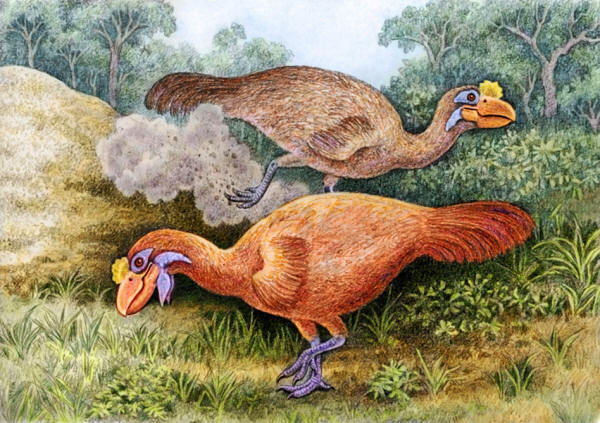
Figure 6:
The conjectured formation of the tumuli
by the large extinct bird Sylviornis neocaledoniae,
seen here scraping soil into a mound for nesting.
From this quite cautious proposal, the idea caught hold. Notably,
since his 1983 co-authored paper listed earlier, archaeologist
Roger Green came to accept this naturalistic explanation for the
mounds as outlined in his influential 1988 article, "Those
mysterious mounds are for the birds." 36
Green's article gives
good background of how the Megapode theory was first pressed into
service to explain the mounds.
That redeeming feature
aside, the reader needs to take some giant leaps of faith:
the concrete cores
are explained away as the wholly natural action of
microorganisms, tiny globules of calcite in the soil somehow
binding rocks and debris together.
Later on, it was proposed
that the nesting birds also introduced vegetation into the mounds
which decayed, providing heat for the eggs.
Subsequently, a
refinement of the theory proposed that the Megapode tidily excreted
into the hole in the top of the mound, the feces becoming the
heating agent for the eggs.
Over time, the droppings
are presumed to have fossilized and become the "cement" found today.
The Megapode theory failed to account for what qualified
archaeologists actually found in the tumuli: the components of the
concrete and the iron artifacts around and beneath the core.
It typically did not
concern its proponents that no trace of bird shell or other material
that would normally indicate an avian presence had been found.
Of course, not all scholars accepted the avian theory. Some
indicated their tacit acceptance of an anthropic origin for the
tumuli, sometimes in regard to the political implications any notion
of pre-Melanesian settlement presents.
See, for example, John
Connell, "New Caledonia or Kanaky? The political history of a
French colony." 37
Others remained open to a
human origin for the tumuli without taking a firm position pro et
con.
A 1995 paper by
Janelle Stevenson and John R. Dodson was open to earlier
arrivals, noting the evidence for human occupation 28,000 years ago
on Buka Island in the nearby Solomons.
They noted the divided
opinions on the mounds, stating that "no cultural material or bird
remains" had been found, but avoided any direct mention of the
cores. 38
In 1999, Stevenson noted
that human arrivals earlier than the Lapita culture (ca. 3200 years
ago), would remain speculative,
"…as long as a human
origin for the so-called tumuli of New Caledonia is
entertained…" referencing a paper by Christophe Sand. 39
A 1997 review by
Patrick V. Kirch of three 1995 publications by Christophe
Sand (until 2019 Director of the Institute of Archaeology of New
Caledonia and the Pacific in Noumea), critiqued the multiple earlier
scholars whose analysis of data suggested the "specter" of an
aceramic, cultural, origin.
Sand's publications were
also criticized for not adequately discussing the Megapode theory.
40
Kirch essentially
maintained his pro-avian position throughout his 2000 book On the
Road of the Winds - An Archaeological History of the Pacific Islands
Before European Contact.
It was republished in
revised form in 2017, but while he accepted tumuli dating as early
as "10,950 BC" it continued the inaccurate (and unreferenced)
assertion that "egg shell" had been found in "the mounds." 41
The avian theory continued to be uncritically accepted when it
reinforced more general positions. A representative statement from
anthropologist Susan O'Connor argued in 2010 against the 1986
Gibbons & Clunie proposal for Pleistocene voyaging between the
eastern edge of the Australian continent and New Caledonia.
Their two primary
arguments for the voyaging rested on the reduced distances needed
for ocean crossings when sea levels were lower and the reported
human derivation of a series of ‘tumuli' or artificial mounds on the
interior plateau of the Isle of Pines.
O'Connor's comment
regarding the tumuli,
"was that they dated
to c. 12,000 BP, [and] have been shown as built by megapodes."
42
Beginning as a
well-intentioned attempt at explanation, for many the "megapode"
theory became a convenience to avoid dealing with the possibility of
a pre-Lapita human presence.
But it was a fiction all
the same. After all, the actual components of the cement cores have
been known since Golson and Chevalier's work was published and,
along with other items we would expect if birds were involved,
neither Phosphorous nor any fragments of egg shells have been found
in the tumuli.
The avian theory was dealt its final fatal blow on 30 March 2016
with publication of a paper by Trevor H. Worthy et al. titled
"Osteology Supports a Stem-Galliform Affinity for the Giant Extinct
Flightless Bird Sylviornis neocaledoniae (Sylviornithidae,
Galloanseres)," in PLOS ONE. 43
Significantly, Christophe
Sand was a co-author.
Page 53 of the paper
discusses the avian explanation for the tumuli:
Sylviornis
neocaledoniae has been identified as a possible maker of large
mounds or tumulion La Grande Terre and Ile des Pins.
However, there is no
evidence of association of this species with these mounds and
eggshell has not been found in them, despite the calcareous
nature of at least those on Ile des Pins.
Given that our analyses
show that S. neocaledoniae has no enhanced morphological adaptations
for digging, such as those displayed by certain megapodes, it is
most unlikely that it is responsible for these tumuli.
Instead these tumuli are likely to be formed by an interplay of
vegetation and erosion as suggested for similar mounds elsewhere.
Even if mounds were
associated with eggshell, then the largest of all Megapodius
species, the New Caledonian endemic and extinct M. molistructor
Balouet and Olson, 1989 would be a more likely contender for their
builder.
The paper concluded as follows (incidentally validating the comments
made by Golson 44 in 1963 about the extinct bird under
discussion):
Our finding that it is a stem galliform (and thus not a megapode)
makes it most unlikely to have been a mound-builder, as this
scenario would require both mound-building and ectothermic
incubation to have evolved twice.
Furthermore, Sylviornis
neocaledoniae shows no specific adaptation for digging to facilitate
mound-building, unlike all extant megapodiids, making it even more
unlikely that it exhibited ectothermic incubation.
THE
"ENVIRONMENTAL" THEORY 2016
Buried within the text reproduced above lay the author's replacement
theory to explain the tumuli:
Instead these tumuli
are likely to be formed by an interplay of vegetation and
erosion as suggested for similar mounds elsewhere.
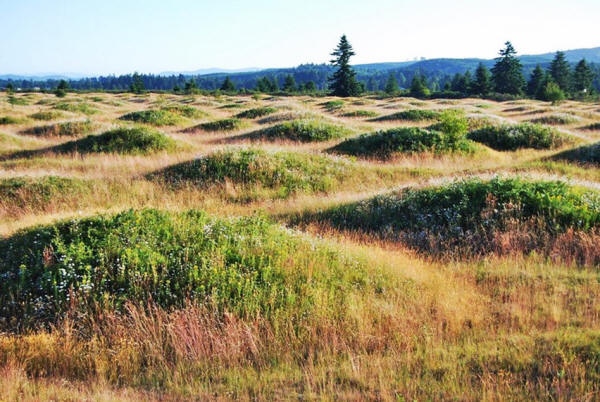
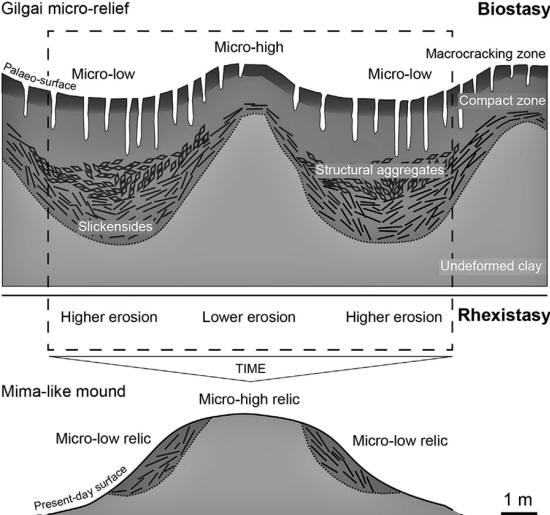
Figure 7A, 7B (2 images):
A view
showing so-called "mima-like mounds"
and a
graphic illustrating two hypothesized erosion scenarios resulting
in the
formation of mima-like mounds.
Graphic
kindly provided by Nathalie Diaz, University of Lausanne.
Can_mima-like_mounds_be_Vertisol_relics_Far_North_Region_of_Cameroon_Chad_Basin
Thus, what could be termed the "Environmental theory" was
introduced. In essence, it proposes that "calcite concretion" may
have developed around the root complex of a long rotted tree,
leading to "differential erosion" in the landscape.
Such structures are
variously known by names such as "mima-like mounds" or "heuweltjie
earth mounds" and are found in various environments around the
world.
However, an examination
of this phenomenon (including sources cited in notes 83-85) reveals
stark differences between such formations and the tumuli.
They are utterly unlike
the tumuli under discussion in this paper. Not only do the former
have smaller dimensions, but these formations lack the tumuli's
central concrete pillar, not to mention its central shaft and iron
appendages.
The suggestion is perhaps
even less plausible than the avian theory it replaces.
THE "BURIAL"
THEORY 2017
In 2008, an important development began with publication by
Frederique Valentin & Christophe Sand of a paper, "Prehistoric
Burials from New Caledonia (Southern Melanesia): A Review." 45
The paper included a
detailed description of the Tüü mound on the Isle of Pines excavated
by Daniel Frimigacci, noting that the Tüü mound likely had original
dimensions approximating the concrete-cored tumuli, but its interior
was taken up with 3 levels of human burials; a base level of loose
bones, with 2 higher levels each containing a full human skeleton.
Dating of the bones
yielded a range between 1930 and 1845 BP and appeared to be primary,
original, interments. The salient points of the text follow:
The study revealed
two stratigraphic levels containing interments (Frimigacci,
1979, pers. comm. 2000).
The lower level,
above a basal level dated to 1930+/–70 BP (UW 655, calibrated
A.D. 50 (80) 245), contained at least one complete adult
skeleton, dated to 1440 +/– 35 BP (UW 766, calibrated A.D. 560
(635) 660).
The body was on its
right side, apparently in a hyperflexed position, knees against
the chest (Frimigacci, 1979:22, figure 15).
The second level contained a complete skeleton of a male about
40 years old (Charpin, 1983). It was on its back in extension.
The surface level included many disarticulated and scattered
human bones that Frimigacci (1979) regards as representing
incomplete skeletons.
A bone sample
returned the early date of 1845 +/– 65 BP (UW 765, calibrated
A.D. 30 (160) 370).
According to Daniel
Frimigacci (1979: 21),
"ce tertre funéraire
est une sépulture collective, il a été édifié au fur et à mesure
des inhumations" [the funeral mound is a collective grave which
was built up by successive inhumations]…
The inhumations were
apparently primary and definitive, displaying variations in
positional modes and an expansion of the tumulus by addition of
sedimentary levels.
By including this description and dating for a prehistoric burial on
the Isle of Pines, the straightforward report effectively again
differentiated burial mounds from the concrete-cored tumuli (which
were left unmentioned throughout the paper).
Surprisingly, this very
description became the linchpin of another theory in 2017 when
Louis Lagarde published his paper, "Were those mysterious mounds
really for the birds?" 46
It is probably the most
important study of the tumuli published since Chevaliers 1963
report.
Positioning itself, in part at least, as a response to Roger Green's
influential argument in support of the avian theory, the paper
reviews the history of scientific enquiry into the tumuli, giving
particular credit to the pioneering work of Daniel Frimigacci in
mapping tumuli in the 1970's and also exploring the coastal burial
mounds such as the one at Tüü.
It then maps the avian
hypothesis in some detail, as well as various earlier attempts to
explain the tumuli geologically. Results of the 2006-2010 survey led
by Lagarde, some never previously published, then serve to
demonstrate why the tumuli must have an anthropic origin.
For all this material we can be grateful, but despite it the report
works up to a most unexpected detour, for notwithstanding the
long-published excavation reports and the author's own wide-ranging
experiences, the report then proposes that the burial mounds are
essentially the same as the tumuli, only the construction material
varying according to the location.
The detour is first
introduced by mentioning an oral tradition claimed by a local
informant mentioning that,
"posts were planted
on the top of earth mounds and scenes of 'torture'."
This claim had been
reported in 1986 by Frimigacci and Golson, 47 and while
Lagarde rightly warns about placing too much weight upon it, he
nevertheless uses it to introduce his primary conclusion in the
paragraph that immediately follows.
In this next discussion, Evidence of funerary practices, the dating
of a burial mound in Gadji to ca. 2309-2003 and 2208 BP is described
as "similar" to the Tüü first century AD dating; on that basis the
plateau tumuli are then declared to have the same ritual, funerary,
function as the earth mound burials.
This stunning claim
completely ignores the various carbon-dating results and, as we
shall see, the uncontested facts established in tumuli excavations.
Lagarde is careful to
first note a fundamental difference between the burial mounds and
the tumuli (one has burials, the other does not), but then
introduces the perplexing claim that the tumuli are void of any
"archaeological material":
Given this [dating]
data, it seems legitimate to suggest a new interpretation as
funerary structures for the earth mounds.
One major difference
separates the plateau structures from the coral plain ones:
in the plateau
tumuli, no evidence of archaeological material is to be
found, whereas every open tumulus of the limestone
environment (through Frimigacci's or our more recent
fieldwork) seems to contain human remains.
(Frimigacci
1986: 29)
More such claims follow:
…after sixty years of
archaeological activity on Isle of Pines, the hypothesis of an
ancient human settlement that would predate Lapita by thousands
of years should be abandoned.
Every dig and survey
campaign has only brought back evidence of material culture in
connection with already known assemblages from mainland New
Caledonia and its global, well-known, diverse cultural
traditions of the last three millennia.
…it has been impossible to discover any kind of artifact that
would indicate a pre-Lapita culture, on Grande Terre or the
Loyalty islands.
The same goes for
Isle of Pines, where no evidence of any culture that would
pre-date Lapita has ever been found, after our four-year
research campaign.
This hypothesis forces to
unite both types of tumuli in the same function, despite the lack of
archaeological evidence coming from the plateau ones.
This is however very much
in phase with the results obtained by Frimigacci.
The plateau earth mounds
and those of the calcareous seashore plain, are structurally and
morphologically identical, their differences coming only from the
environment in which they were erected.
Typologically, they are identical and linguistically, the people of
Isle of Pines call both kinds purè: furthermore they stand in
similar proportions in a population/space ratio, as hundreds of them
are to be found in both chrome and coral environments.
If one of the types was
much rarer, if language could differentiate the structures, if the
inner structure of the earth mounds was indeed typologically
different, we would have separated the tumuli into two categories.
On the contrary, we stand
confident with the hypothesis of a unique anthropogenic tradition in
which minor differences are to be explained by the surrounding
environment.
This is not our idea, as Frimigacci was the first to point out the
similarities existing between the two populations of tumuli, and to
try to explain the use of the plateau ones by the contents of the
seashore ones (Frimigacci 1986 - 32).
His archaeological
excavation of the human remains in the Tüu tumulus is for us the key
finding of the past sixty years.
Arguing at some length that human bones can completely vanish under
conditions of soil acidity and exposure to the elements via the
"tiny limestone blocks" covering the tumuli, Lagarde concludes:
…we suggest the
possibility that the tumuli are of anthropic origin, bear a
ritual/funerary function and that at least some of them were
used as funerary mounds for primary burials.
We hope to have brought
forward that the tumuli of the Isle of Pines are more
archaeologically complex than straightforward, natural, bird-made
structures.
Although being the last
pieces of evidence that could have supported the theory of a
extremely ancient human settlement of the New Caledonian
archipelago, they actually belong to the recent three millennia of
Austronesian presence.
In our opinion, they
illustrate, at least partly, the funerary practices of a time span
of five to six centuries, between the end of the first millennium BC
and the first centuries AD.
How can we reconcile
the fact that the interiors of the burial mounds and the tumuli
are, in truth, actually radically different?
What can account for
such a disconnect between the uncontested archaeological
evidence and such explanations as this report offers?
Are we seeing the
rise of a new default position to replace the discredited avian
theory?
If so, then as with all
the other attempts at explanation the tumuli it comes at the expense
of the archaeological evidence. As at the time of writing such
questions remain unresolved. 48
NEW
INVESTIGATIONS FROM 2017
The author's explorations on the Isle of Pines commenced in 2017 and
first undertook a detailed examination of the original tumulus
excavated by Chevalier.
This was to reveal that
this concrete core had a circular vertical shaft throughout its
length.
As Chevalier's excavation
report did not mention such a significant feature this unanticipated
find was initially perplexing, but it was concluded that his
excavation had not cleared the entire summit of the tumulus before
work was abruptly halted.
Thus, the opening at the
very centre of the top of the core - 1 foot/30 cm in diameter - was
missed by him.
After Chevalier returned
to the main island, local workers continued removing the mound's
iron gravel as a source of road-making material until only the
concrete core remained but the shaft would have been of little
interest even if noticed.
In fact, as already
noted, Jack Golson's 1959-1960 survey reports had mentioned this
feature in many of the tumuli he and his team had examined.
In his notes, Golson
designated the concrete cores as "anchors" and the shafts as
"postholes," but could not suggest what purpose the latter served.
49
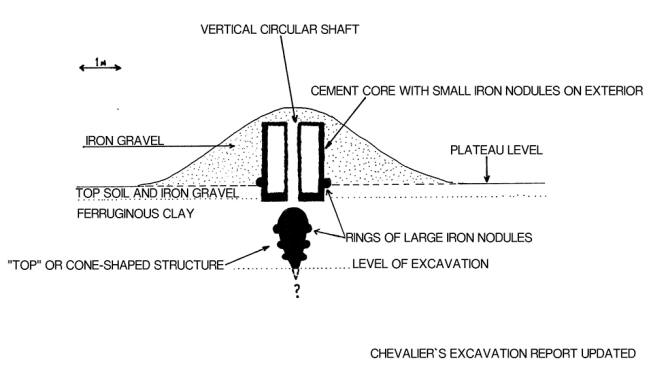
Figure 8:
Chevalier's 1963 excavation report (see Fig. 5)
redrawn with the circular shaft in the concrete core added.
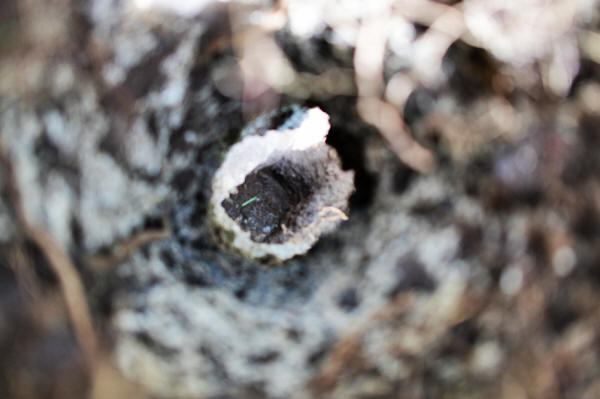
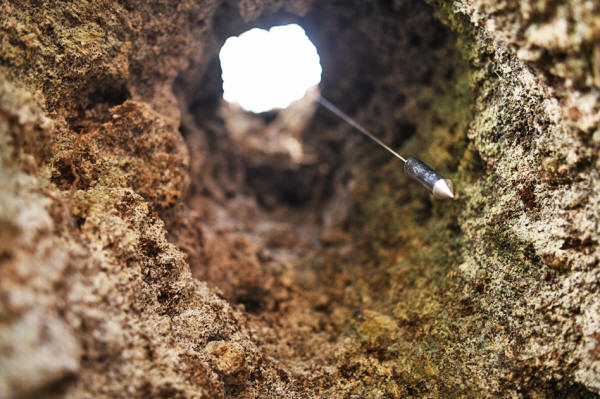
Figure 9A, 9B (2 images):
Views looking down and up showing the 30 cm wide circular shaft
running vertically through the middle of the concrete core
of the tumulus excavated by Chevalier in 1959.
Photographs by the author 2018, 2020.
THE CEMENT
ANALYSIS UPDATED
From abundant large excavation debris still surrounding the tumulus,
the author obtained samples of the interior concrete and submitted
them for elemental composition analysis in an Australian laboratory.
50
Following is a comparison
of the results from Chevalier's analysis of the first tumulus
excavated on the Isle of Pines with the author's 2018 analysis of
the same structure, of the interior mortar in both cases:
Chevalier
Analysis/Author Analysis
Loss on ignition % 33.20 41.8
Fe2O3 26.57 6.6
Fe 18.60 nil recorded
Al2O3 4.00 0.4
CaO 34.25 48.2
MgO traces 0.7
SiO2 1.80 < 0.05
SO3 not recorded 0.1
MgO not recorded 0.7
K2O not recorded 0.03
Na2O not recorded < 0.05
P2O5 not recorded < 0.05
TiO2 not recorded < 0.05
Mn2O3 not recorded 0.08
SrO not recorded 0.1
Cl not recorded 0.011
A REVISED
CONSTRUCTION SEQUENCE
A construction sequence can now be proposed that incorporates all
the features of the tumuli now known.
It is based upon Luc
Chevalier's 1963 proposal for how the cement core was built on the
Isle of Pines, but substantially expands and updates it.
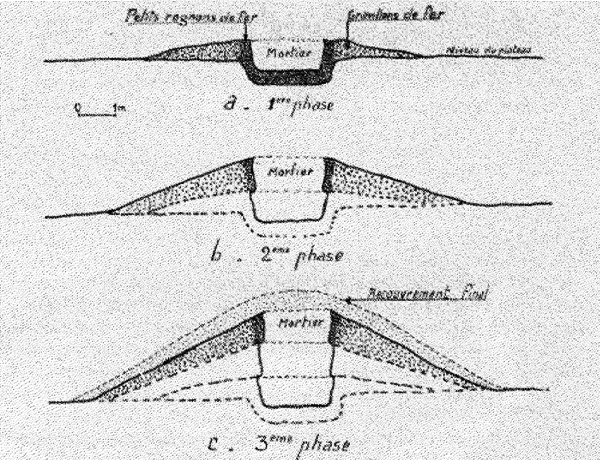
Figure 10:
Construction sequence of the cement core
on the
Isle of Pines as proposed by Chevalier, 1963 [his note 6].
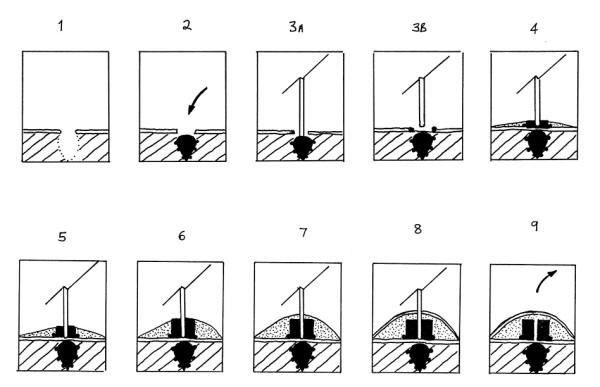
Figure 11:
Author's proposed construction sequence
in cross-section, incorporating all known features.
Stage 1
The necessary first step required excavation of a hole through
the topsoil and more than 2 meters deep into the ferruginous
clay layer beneath.
Stage 2
This was followed by placement in the hole of the almost 8
foot/2.4 meters long Fe cone-shaped object, its point downwards
and with at least 3 rings of Fe nuggets placed around it,
perhaps to stabilize it in a vertical position.
Their presence,
incidentally, makes it clear that the cone-shaped object is not
an artifact from iron being leached from the surface and somehow
precipitating into a geometrical shape below the tumulus.
Stage 3A
Vertical placement of a tubular pillar or "pylon" (a smooth tree
trunk?) of unknown length centered above the cone. Current
excavation data lacks the resolution to determine which of these
two possibilities is correct: (A) the pylon may have been placed
in direct contact with the rounded top of the cone, or:
Stage 3B
the pylon may have been separated from the top of the cone by a
shallow bed of Fe nodules and soil, the scenario utilized in
this model.
Stage 4
Over a bed of medium-sized Fe nodules, the first cement layer
was poured into the hole, thus stabilizing the pylon in
position.
At ground level the
base of the cement block was surrounded (delineated?) by large
Fe nodules, while a circular base layer of Fe gravel was added
around the cement core to the same height.
Local materials, consisting primarily of iron gravel but
inevitably also some soil, were scraped up in a circular fashion
around the structure, thus differentiating the scraped area from
the normal surroundings, creating the "aureole" effect still
visible in aerial images, as Chevalier noted.
Throughout its
erection, the outside surface of the cement core was reinforced
with various sized Fe nodules, in contrast to the softer cement
interior.
Stage 5
The second layer of cement was added, maintaining the same
dimensions as the first layer. Likewise, the Fe gravel was built
up around the core to the same level.
Stage 6
The third and final layer of cement was added, maintaining the
same dimensions and the Fe gravel built up around the core to
the same level.
Stage 7
A final, substantial, layer of Fe gravel was added to entirely
cover the cement core, completing the rounded shape of the
tumulus.
The small size and
particularly the weight of the gravel is such that it would have
rapidly filled the hole in the cement core, assuring us that the
pylon, or at least a "cap" of some type, was in place when the
gravel covering was added to the tumulus.
The simplest
explanation is that the pylon remained in place throughout.
Stage 8
It is unclear whether a final, thin, layer of soil was added to
cover the entire tumulus or whether the soil already mixed in
with the gravel sufficed. In either event, the tumulus was now
complete with only the pylon protruding from the hole in the
cement block.
Stage 9
At some point the pylon was removed (or if organic, such as a
tree trunk, perhaps rotted away) and the tumulus assumed its
innocuous modern appearance, giving no hint of the substantial
cement and iron structures within and below it.
At most tumuli in the present, the vertical hole in the cement
core is covered over by the vegetation growing in the tumulus
covering; for that reason, the hole was not readily visible to
early investigators.
Data are currently
insufficient to ascertain whether the shafts became clogged with
debris after removal of the pylon.
While apparently
intended to provide additional stability and strength, the very
substantial covering of iron gravel and soil also effectively
served to protect the tumuli from weathering and disguised their
nature until very recent times. 51
THE FUNCTION
OF THE TUMULI
Of the numerous reasons for building any structure elevated above
its surrounds (to provide a higher vantage point, to elevate
something for increased visibility, to use gravity to move something
(e.g. water) downwards, to funnel something (e.g. smoke) upwards and
so on), only a small number are potentially applicable to the
tumuli.
These are as follows:
1.
A burial site
As demonstrated
earlier, whatever else they may be, the structures are
manifestly not burial mounds. No skeletal material, or the
cultural artifacts associated with burials, have yet been
observed in the concrete-cored tumuli.
Human burials, of
course, are found in a variety of mounds or sub-surface sites
that do not resemble in any way the structures under discussion
here.
The human burial
mounds are smaller in height and extent, have no cement core at
their centre and are generally found in situations and locales
more commonly associated with funeral remains.
Purely as a note of interest, in 2019 the author and others
examined a large concrete-cored tumulus on private land at Gadji
which had been disturbed by road construction; a small number of
loose human bones were located just beneath the surface (a depth
of ca. 15 cm), an act of later, accretional, burial using the
surface of the mound as a convenience.
Here, in a classic
situation of an apparent exception proving the rule, the
obviously recent very shallow burial helps emphasize that these
structures were not originally intended to inter human remains,
a distinction readily apparent to most observers over the years.
52
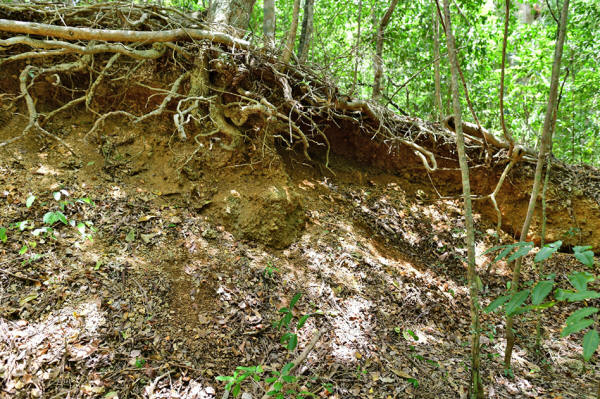
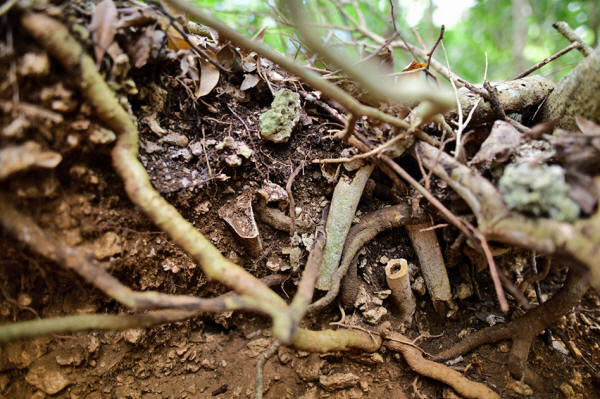
Figure 12A, 12B (2 images):
The relatively recent burial just below the surface
of a large tumulus in Gadji.
The damaged concrete core in the centre of the tumulus
and the burial location on the right side
are both visible in image 12A.
Images by author, 2018.
2. As an
elevated vantage point or watchtower
This proposal lacks
any merit as abundant opportunities for higher views are
afforded by adjacent land features and trees. And, in any case,
it does not explain the cement core construction and the sheer
number of tumuli built.
3. As a
ceremonial or ritual centre
This concept finds
some support in a handful of locations where rock-lined paths
and other cultural indicators have been found.
Most recently, the
2006-2010 survey on the Isle of Pines identified pathways,
depressions and large ferralitic boulders atop 6 tumuli.
While ceramic sherds
remained "extremely rare" on the Iron Plateau, indications of
eaten seashells from the coast or "fossil uplifted limestone
blocks from the forest" were noted at 8 tumuli. 53
Investigation is
still required to determine if these works are contemporaneous
with the tumulus, or a later expansion by others. Logically, the
likelihood that the stones date to a much later period seems to
be strengthened by their rarity.
The oral tradition noted earlier that mentioned that "posts were
planted on the top of earth mounds and scenes of 'torture'" does
not offer support for ritual use any more than it does for a
funerary function; a post or tree trunk does not require a large
concrete base to ensure it stands upright.
If these traditions
have any substance they must refer to a usage postdating the
tumuli construction.
4. As an
artistic expression
The most obvious
objection to the structures being an art form that developed
uniquely in the area, is that their most impressive features -
the interior cement block surrounded by iron nodules - was
completely covered over with earth and clearly not intended to
be visible.
Nor would a circular
earthen mound require such an interior, one that remained
unseen. We would expect that an object of art would be adorned
with other features, either individualistic or symbols common to
the community.
Instead, with the
exception of the few locations noted in #3, we find only
conformity, an austere plainness that suggests a strictly
utilitarian, functional, purpose, not an artistic one.
A NEW PROPOSAL
By showing what the tumuli are not and cannot be, the purpose of
these structures can now be proposed with some certainty.
From an engineering
viewpoint the large cement blocks within the tumuli have the primary
purpose of stabilizing a circular pillar or pylon, standing in the
vertical shaft of the core but later removed or decomposed, for no
trace of them now remains.
Nor is there any hint of
what the pillar/pylon may have supported and why it required such a
degree of stabilization, as evidenced by the massive cement base.
Determining this is now the challenge going forward.
Ascertaining the function
of the cone-shaped metal object beneath the shaft may offer the most
promising line of future investigation.
Nothing to date suggests that the tumuli construction took place
over an extended period where we would expect to see improvisations
or the development of different styles. Everything suggests a
one-time concentrated effort.
Only two of the Paita tumuli preserve any trace - surplus raw
material - of the construction process and, just possibly, of a
stage of early experimentation with local materials.
If so, we can speculate
that the silica-based process may have been abandoned in favor of
the iron resources readily available on the Isle of Pines.
CONCLUDING
REMARKS
More answers will reveal themselves when modern archaeologists
engage more fully with the structures than they have heretofore.
It would require little
effort to completely reveal the interiors of those structures that
are already partly and even fully exposed; in particular, the large
cone-shaped iron structure which is the most likely feature to fully
reveal the final answers to the mystery.
Was this a type of
anchor, such as our modern anchor spears, for the pylon or pillar
sitting directly above?
While this artifact has
only been reported from one site, it beggars belief to think that
Chevalier chanced upon the one tumulus that had a symmetrical
cone-shaped metal object positioned exactly below the shaft in the
central core; it must be an integral part of other tumuli.
For that matter, we
cannot be sure that nothing else lies beneath the cone itself -
no-one has looked.
The incongruity of the scientific establishment, particularly
archaeologists and historians, in having Chevalier's excavation
reports since 1963 while still proposing solutions that do not, in
any way, account for what lies within these structures is
staggering.
The tumuli, after all,
remain readily available for examination. This inaction must
represent, in large part at least, the instinctive avoidance of
something that challenges present paradigms about human settlement
in the southern Pacific.
Surely the time is long past when data seemingly at odds with our
current thinking are ignored.
Perhaps in them lies a
key to a broader understanding of what influences and events have
shaped the Pacific's distant past even if, as the data in his paper
suggests, it requires a reconsideration of what we can possibly term
the "Neolithic" explanation.
It is hoped that this
paper will encourage archaeologists and historians of this region to
re-engage with facts and move beyond demonstrably inadequate
theories in solving the puzzle these structures still represent.
In the 21st century, the enigma remains. And if
Chevalier's questions were perceptive in 1963, decades later they
can be re-stated and expanded:
The identity of the tumuli builders remains, of course, the crux of
the mystery, but they certainly predated the arrival of the
Melanesians who became the generally regarded indigenous culture and
had no ability to manufacture concrete.
Who were they?
Where did their
ability to make high-quality concrete come from at a time when
this technology was unknown, certainly in the Pacific at least?
What possible motivation or purpose could cause a people to
invest so much effort to erect more than 400 of these
structures, each averaging a volume of 500 cubic meters? 54
Why did such a massive effort leave no other traces of its life
and activities - no tools, bones, charcoal, pottery or other
cultural artifacts, either within the tumulus or around it?
Why did they not use this ability to construct other works,
their dwellings, their burials and their sacred places before,
during, or after the tumuli construction?
Over time, why was the ability to manufacture such a useful
material as concrete not exported to other islands?
Why was this capacity
not passed down to the Melanesians who became the generally
regarded indigenous culture?
Indeed, why did this
capacity not arise elsewhere in the region?
The prescient questions
of Chevalier, pondering the mystery of a distant, unknown, people
who knew how to make durable concrete on a large scale, still await
resolution...
VIDEO
NOTES
1."The [Isle of
Pines] is considered to be a kind of "archaeological nightmare"
due to the presence of no less than 200 earth mounds…" Louis
Lagarde & Andre-John Ouetcho, "Rocks, pottery and bird bones:
new evidence on the material culture of Isle of Pines (New
Caledonia) during its 3000-year-long chronology," in Christophe
Sand et al. eds. The Lapita Cultural Complex in time and space:
expansion routes, chronologies and typologies (Noumea: IANCP,
2015), Archeologia Pasifika 4 series.
https://www.researchgate.net/publication/280976124_Rocks_pottery_and_bird_bones_new_evidence_on_the_material...
2. Jacques Avias, "Contribution a la Prehistoire de L'Oceanie:
les Tumuli des Plateaux de Fer en Nouvelle-Caledonie" in Journal
de la Societe des Oceanistes (1949), 15-50 (author transl.)
https://www.persee.fr/doc/jso_0300-953x_1949_num_5_5_1625
3. Louis Lagarde, "Geological anomalies?" in "Were those
mysterious mounds really for the birds?" Reappraising the Isle
of Pines' puzzling tumuli (New Caledonia)" in For a history of
Oceanian prehistory: historiographical approaches to
French-speaking archeology in the Pacific (Noumea: Pacific CREDO
publications, 2017).
4. Luc Chevalier, "Le problème des tumuli en Nouvelle-Calédonie,"Bulletin
périodique de la Société des Études mélanésiennes 14-17 (Noumea:
Société des Études mélanésiennes, 1963), 24-42.
www.archeologie.nc/docus/tumulcheval.pdf. The section titled
"Tumulus A Cylindre Double" reports the examination of an oval
double-cored tumulus and notes two others visible in aerial
images. Three related reports by Chevalier are also on file at
the New Caledonia Museum in Noumea: "Observations faites sur un
tumulus ouvert a LIIe des Pins" (3 pages) dated October 6, 1959;
"Note sur les tumuli de Nouvelle-Caledonie" (3 pages dated
October 21, 1960 regarding the mortar analysis) and a 5 page
handwritten draft dated January 15, 1961 of the article that
would appear in 1963.
5. Chevalier (1963), Figs. 4, 5.
6. Chevalier (1963). See Fig. 7 sketch in "Tumulus A Cylindre
Double."
7. Chevalier (1963), Fig.10.
8. Chevalier (1963), Fig. 5.
9. See Chevalier (1963) Figs.10 and 11 with notes.
10. Roger Curtis Green & J. S. Mitchell, "New Caledonian Culture
History: A Review of the Archaeological Sequence" in New Zealand
Journal of Archaeology vol. 5 (1983), 19-68.
11. Theophile Auguste Mialaret, L'île des Pins, son passé, son
présent, son avenir: colonisation & ressources agricoles (Paris,
J. André, 1897). Reprinted in 2012 (Paris: Hachette Livre BNF).
12. R. H. Compton,
"New Caledonia and the Isle of Pines," The Geographical Journal
vol. 49, no. 2 (London: Feb. 1917), 81-103, esp. 102-103.
https://www.jstor.org/stable/1779337
13. Jacques Avias (1949), 15-50.
14. Jack Golson, "The Tumuli of New Caledonia" in "Report on New
Zealand, Western Polynesia, New Caledonia, and Fiji," Asian
Perspectives vol. 5, no. 2 (Winter, 1961), 170-172.
15. Jack Golson, "Rapport sur les fouilles effectuees a l'ile
des Pins (Nouvelle Caledonie) de Decembre 1959 li Fevrier 1960,"
in Bulletin périodique de la Société des Études mélanésiennes
N.S. 14-17 (1963), 11-24; Daniel Frimigacci & Jack Golson, "Tout
Ce Que Vous Pouvez Savoir Sur Les Tumulus, Meme Si Vous Osez Le
Demander" (1986), copy in author's possession.
16. Chevalier (1963).
17. Chevalier (1963), Fig. 5 in "Fouilles Sous Le Cylindre."
18. Chevalier (1963), see "Tumulus A Cylindre Double."
19. Chevalier (1963), see "Elevations Secondaires" and "Fouilles
Au Tumulus no 2."
20. G. Delabrias et al. "GIF Natural Radiocarbon Measurements
11," Radiocarbon, vol. 8 (Yale: The American Journal of
Science,1966), 88-89 (Gif-298, 299 and 300).
https://journals.uair.arizona.edu/index.php/radiocarbon/article/view/17972/17709
21. T. A. Rafter et al. "New Zealand radiocarbon reference
standards" Proceedings of the 8th International Conference on
Radiocarbon Dating. Vol. 2, (1972), 625-675, as referenced in
Lagarde "Were those mysterious mounds really for the birds?"
(2017). The same paragraph cites Dubois (1976) for the 12,900
ybp Placostylus dating although the dating was actually from
Chevalier, as reported in G. Delabrias et al. (1966) - see note
20.
22. H. C. Brookfield & Doreen Hart, Melanesia: A geographical
interpretation of an island world (London: Methuen, 1971), 78
references both Chevalier and Golson's work and summarized:
"…there seem to have been earlier - perhaps much earlier -
inhabitants of New Caledonia, who built tumuli of a concrete
made of coral lime…"
23. Fr. Marie-Joseph Dubois, "Trouvailles à l'île des Pins,
Nouvelle-Calédonie," Journal de la Société des Océanistes 51-52
(1976), 233-239. See especially the section Purè.
https://www.persee.fr/doc/jso_0300-953x_1976_num_32_51_2744
24. Richard Shutler Jr. "Radiocarbon dating and Oceanic
prehistory" in Archaeology and Physical Anthropology in Oceania
13, 2&3 (1978), 222 accepted that "…by 10,000 years ago, a non-Austronesian,
aceramic, pre-Neolithic, tumuli-building people were in Island
Melanesia, on New Caledonia and Ile de Pines…"
25. Peter Bellwood's opus Man‘s Conquest of the Pacific
(Auckland: Collins, 1978), 250 concluded: "The Isle of Pines
also provides one of the more unusual archaeological mysteries
of the Pacific….[dating gives] a very odd range of dates between
1000 and 6000 BC. which may be of questionable value." However
he notes: "Furthermore, it is not at all certain that the mounds
are man-made, but if they are, then perhaps a Lapita connection
may be found, or they may even have been built by some unknown
pre-Lapita inhabitants of New Caledonia."
26. Roger Green & J. S. Mitchell (1983) sensibly accept that the
concrete cores are an important indicator of a "cultural"
origin, dismissing attempts to label them as "natural" by
highlighting Chevalier's analysis of the concrete. They noted
that some snail shells attached to the cores and in the cement
matrix provided the oldest dating and believed some dating
inaccuracies might exist, but, despite preferring a later
dating, still accepted that the tumuli are manmade and likely
ancient: "…the enigmatic tumuli, or concrete-cored mounds,
provide a number of issues, the answers to which remain
uncertain. However, there are several lines of evidence to
suggest that these structures are man-made…at present these
tumuli present a problem which only further archaeology and more
data will resolve…it seems necessary to continue attributing at
least some of these tumuli with their cylinders and other
features to human activities, as they provide a range of
evidence not easily explained by any set of natural events…It is
only if some much earlier age estimates for tumuli are adopted
that they might be taken to imply initial occupation by a group
of non-Austronesian speakers."
27. Kerry Ross Howe in Where the Waves Fall (Honolulu:
University of Hawaii Press, 1984), 31 states: "New Caledonia
poses one of the more interesting problems in Oceanic
archaeology…the conical tumuli with an inner cylinder composed
of hard lime mortar. They are clearly of human making…Three
radiocarbon dates put their age at about 7000, 9500, and 13,000
years…These amazing dates may simply result from the testing of
material that was long dead before being used to build the
tumuli. On the other hand it is possible that the dates are
correct."
28. John R. H. Gibbons & Fergus G. A. U. Clunie, "Sea Level
Changes and Pacific Prehistory: New Insight into Early Human
Settlement of Oceania" in The Journal of Pacific History vol.
21, no. 2 (April, 1986), 58-82 accepted that at least some of
the 400 tumuli were "apparently man-made."
29. Christophe Sand, "Lapita and non-Lapita ware during New
Caledonia's first millennium of Austronesian settlement" in The
Pacific from 5000 to 2000 BP (Paris: Institut de recherche pour
le developpement, 1999), 139-159. Sand treated the dating as
established: "The discovery of large tumuli, dated between
13,000 and 4000 BP, was at the same time seen as indication of
an old settlement of southern Melanesia by modern humans…,"
later noting "The significance of this dating remains unclear…"
30. Patrick Vinton Kirch, On the Road of the Winds - An
Archaeological History of the Pacific Islands Before European
Contact (Berkeley: UC Press, 2000 and 2017), 135 accepted tumuli
dating as early as "10,950 BC" while still maintaining support
for the avian explanation.
31. Avias (1949), 48.
32. Frimigacci & Golson (1986), 1.
33. For example, see Lagarde, "Isle of Pines and the tumuli
research history" in "Were those mysterious mounds really for
the birds?" (2017), noting particularly publications of engineer
Bernard Brou, whose 1977 book, Préhistoire et société
traditionnelle de la Nouvelle-Calédonie (Noumea: Publications de
la Société d'Études Historiques de la Nouvelle-Calédonie) served
to popularize the migration theories of Avias, although Brou
himself had favoured a geological explanation.
34. In 2018, the author published a response to the 2017 release
of alleged US intelligence documents that included a claim that
traces remained on the Isle of Pines of an extraterrestrial
visit ca. 11,500 BP. Such an explanation will seem fantastic in
direct proportion to how current one's knowledge is of
astronomical advances; the author retains an open mind.
35. Francois Poplin & Cecile Mourer-Chauvire, "Le Mystere de
Tumulus de Nouvelle-Caledonie," in La Recherche 16 (Paris,
September, 1985), 1094. The same authors published "Sylviornis
neocaledoniae (Aves, Galliformes, Megapodiidae), oiseau Géant
éteint de l'ile des Pins (Nouvelle- Calédonie)," Geobios vol.
18, no. 1 (December 1985), 73-105.
https://www.sciencedirect.com/science/article/pii/S0016699585801820
36. Roger Green, "Those mysterious mounds are for the birds,"
Archaeology in New Zealand vol. 31, no. 3 (1989), 153-158.
37. John Connell, New Caledonia or Kanaky? The political history
of a French colony. Pacific Research Monograph 16 (Canberra:
Research School of Pacific Studies, ANU: 1987), 1-2.
38. Janelle Stevenson & John R. Dodson, "Palaeo-environmental
Evidence for Human Settlement of New Caledonia" in Archaeology
in Oceania vol. 30, no. 1 (1995), 36-41.
39. Janelle Stevenson, "Human Impact from the Paleo-environmental
Record on New Caledonia" in Jean-Christophe Galipaud & Ian
Lilley, eds. Le Pacifique de 5000 h 2000 avant le present / The
Pacific from 5000 to 2000 BP (Paris: Institut de Recherche pour
le Developpement, 1999), 251-258.
40. Patrick V. Kirch, "Resolving the Enigmas of New Caledonian
and Melanesian Prehistory: A Review," Asian Perspectives vol.
36, no. 2 (Fall 1997), 232-244]. An email exchange between the
author and Kirch in 2017 served to emphasize his support for the
avian hypothesis.
41. Patrick Vinton Kirch (2000 and 2017). The egg shell claim
appears on p.135 in the 2007 edition.
42. Sue O'Connor, "Pleistocene Migration and Colonization in the
Indo-Pacific Region" in Anderson et al. eds. The Global Origins
and Development of Seafaring (Cambridge: McDonald Institute for
Archaeological Research, 2010), 46.
43. Trevor H. Worthy et al. "Osteology Supports a Stem-Galliform
Affinity for the Giant Extinct Flightless Bird Sylviornis
neocaledoniae (Sylviornithidae, Galloanseres)," PLOS ONE 11(3):
e0150871 (2016).
https://journals.plos.org/plosone/article?id=10.1371/journal.pone.0150871
44. Golson (1963).
45. Frederique Valentin & Christophe Sand, "THE TÜÜ BURIAL
MOUND, ISLE OF PINES" in "Prehistoric Burials from New Caledonia
(Southern Melanesia): A Review," Journal of Austronesian Studies
2 (1) (Taiwan: National Museum of Prehistory, June 2008), 5.
https://www.researchgate.net/publication/260707175_Prehistoric_burials_from_New_Caledonia
46. Louis Lagarde, "Were those mysterious mounds really for the
birds?" (2017).
47. Frimigacci & Golson (1986), 31.
48. Louis Lagarde did not respond to multiple queries in early
2020 seeking clarification of his claim that the plateau tumuli
contain "no evidence of archaeological material."
49. Discussed in Golson (1961), 171. Additional instances where
these features were found appear in unpublished excavation notes
of Jack Golson in possession of the author.
50. Cement Australia, Darra Laboratory, Queensland, NATA No.
188, dated July 19, 2018.
51. A basic comparison of equal quantities by the author yielded
these results: 125 g of iron gravel was heavier than dry soil at
91 g, and even soil fully saturated with water at 113 g.
52. A review of earlier literature discussing the tumuli will
reveal how often the clear distinction between burial mounds and
the tumuli was apparent to skilled observers. One of the
earliest such accounts, for example, is Alphonse Riesenfeld's
wide-ranging Megalithic Culture of Melanesia (Leiden: Brill,
1950), 539 - 572, an interesting commentary on the times and
while dated, still of value.
53. See Lagarde (2017) "Anthropic aspects of the plateau tumuli"
in "Were those mysterious mounds really for the birds?" in
Lagarde (Doctoral Thesis, 2012), Peuplement, dynamiques internes
et relations externes dans un ensemble géographique cohérent de
Mélanésie insulaire: L'exemple de l'Ile des Pins en Nouvelle-Calédonie
(Paris: Université Paris I - Panthéon-Sorbonne), Tome 1, espec.
244-245).
54. Lagarde provides an estimate of tumuli volumes as averaging
about 500 cubic meters; see Lagarde, "Geological anomalies?" in
"Were those mysterious mounds really for the birds?" (2017).
| 


















